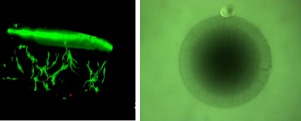当前位置:
X-MOL 学术
›
J. Ind. Eng. Chem.
›
论文详情
Our official English website, www.x-mol.net, welcomes your
feedback! (Note: you will need to create a separate account there.)
In vitro 3D skin model using Gelatin methacrylate hydrogel
Journal of Industrial and Engineering Chemistry ( IF 5.9 ) Pub Date : 2018-10-01 , DOI: 10.1016/j.jiec.2018.05.037 Bong Shin Kwak , Wonho Choi , Joong-won Jeon , Jong-In Won , Gun Yong Sung , Bumsang Kim , Jong Hwan Sung
Journal of Industrial and Engineering Chemistry ( IF 5.9 ) Pub Date : 2018-10-01 , DOI: 10.1016/j.jiec.2018.05.037 Bong Shin Kwak , Wonho Choi , Joong-won Jeon , Jong-In Won , Gun Yong Sung , Bumsang Kim , Jong Hwan Sung

|
Abstract Interests in in vitro skin models have been growing. Collagen, which is a main scaffold material for in vitro 3D skin models, has weak mechanical properties, often resulting in undesirable contraction. The physiological characteristics of the skin models often depend on the matrix in which cells are cultured. In this study, we developed a 3D skin model using gelatin methacrylate. The mechanical and transport properties were studied, and attachment and growth of fibroblasts and keratinocytes were examined. Fibroblasts preferred softer matrix, whereas HaCaT cells preferred harder matrix of gelatin methacrylate. This study provides information for developing in vitro skin models.
中文翻译:

使用明胶甲基丙烯酸酯水凝胶的体外 3D 皮肤模型
摘要 对体外皮肤模型的兴趣一直在增长。胶原蛋白是体外 3D 皮肤模型的主要支架材料,其机械性能较弱,经常导致不良收缩。皮肤模型的生理特征通常取决于培养细胞的基质。在这项研究中,我们使用甲基丙烯酸明胶开发了一个 3D 皮肤模型。研究了机械和运输特性,并检查了成纤维细胞和角质形成细胞的附着和生长。成纤维细胞偏好较软的基质,而 HaCaT 细胞偏好较硬的甲基丙烯酸明胶基质。该研究为开发体外皮肤模型提供了信息。
更新日期:2018-10-01
中文翻译:

使用明胶甲基丙烯酸酯水凝胶的体外 3D 皮肤模型
摘要 对体外皮肤模型的兴趣一直在增长。胶原蛋白是体外 3D 皮肤模型的主要支架材料,其机械性能较弱,经常导致不良收缩。皮肤模型的生理特征通常取决于培养细胞的基质。在这项研究中,我们使用甲基丙烯酸明胶开发了一个 3D 皮肤模型。研究了机械和运输特性,并检查了成纤维细胞和角质形成细胞的附着和生长。成纤维细胞偏好较软的基质,而 HaCaT 细胞偏好较硬的甲基丙烯酸明胶基质。该研究为开发体外皮肤模型提供了信息。











































 京公网安备 11010802027423号
京公网安备 11010802027423号